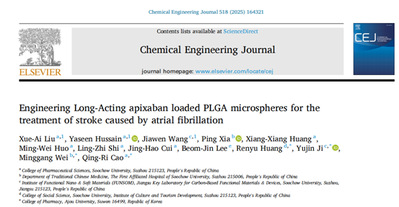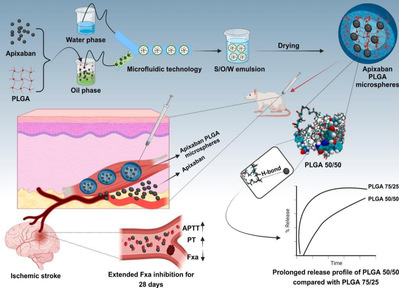Professor Qing-Ri Cao's laboratory publishes a research paper on novel long-acting microsphere technology in Chemical Engineering Journal
Atrial fibrillation (AF) is a common persistent arrhythmia in adults, which significantly increases the risk of stroke and has become a major global public health challenge. Statistics show that the probability of stroke in AF patients is 5 times that of the general population. However, traditional oral anticoagulants have obvious drawbacks in medication, such as poor patient compliance, easy dosage errors, and even possible thromboembolic events due to missed doses. Although Apixaban is a direct factor Xa inhibitor with definite efficacy, its multiple daily tablet administration limits the effectiveness of long-term treatment. How to construct a long-acting and safe delivery system has become a key issue to be solved urgently in the field of anticoagulant therapy.

Recently, Professor Qing-Ri Cao's team from the School of Pharmaceutical Sciences, Soochow University, in collaboration with the First Affiliated Hospital of Soochow University and the Institute of Functional Nano & Soft Materials, Soochow University, published a research paper in the top journal of Materials Science (Zone 1) Chemical Engineering Journal (2025 IF: 13.3). They innovatively developed long-acting Apixaban PLGA microspheres, achieving the transformation from "immediate release" to "sustained release" through technological breakthroughs. The research team prepared drug-loaded microspheres with smooth surfaces and uniform particle sizes using microfluidic technology combined with the S/O/W double emulsion-solvent evaporation method. Through optimization by single-factor experiments and orthogonal design, a stable formulation with high drug loading was obtained. Using molecular simulation, it was first revealed that there is a strong hydrogen bond interaction between Apixaban and PLGA 50/50 material, successfully transforming PLGA 50/50, which originally has a rapid release, into a long-acting sustained-release carrier. Pharmacokinetic and pharmacodynamic studies showed that the blood drug concentration was maintained stably, the anticoagulant effect in animal models was continuously significant, and the biocompatibility test confirmed its safety.

The innovative value of this research is reflected in three aspects: (1) Technological breakthrough: By reprogramming the material-drug interaction, the technical bottleneck of poor sustained-release ability of PLGA 50/50 is solved, providing new ideas for the development of long-acting preparations. (2) Potential for clinical transformation: The microsphere preparation can greatly reduce the frequency of administration (from twice a day to a single injection maintaining for several weeks), significantly improve the medication compliance of AF patients, and reduce the risk of stroke. (3) Interdisciplinary approach: Combining molecular simulation, microfluidic technology and pharmacological verification, it establishes a standardized research paradigm for the design of complex drug delivery systems. This achievement provides a better solution for the long-term prevention and control of AF-related strokes. If it enters clinical practice in the future, it may change the existing pattern of anticoagulant therapy.
Xue-Ai Liu, a master's student at the School of Pharmaceutical Sciences, Soochow University, is the first author of the article, and Professor Cao Qingri is the corresponding author.
Full-text link: https://doi.org/10.1016/j.cej.2025.164321
Corresponding Author:

Qing-Ri Cao, Professor and doctoral supervisor of the School of Pharmaceutical Sciences, Soochow University. He obtained his Ph.D. degree in Pharmacy from Kangwon National University, South Korea in 2004. His research direction is the research and development of novel nano and controlled-release preparations. Guided by industrialization, he has carried out academic and industrialization research, and accumulated rich experience in new drug/generic drug development, project management and operation. He has completed and is researching more than 30 industrialization projects in the field of drug delivery (such as gene carriers, long-acting microspheres, liposomes, controlled-release preparations). He has led the research and development of 9 medical products that have been successfully marketed, 1 class 1 new drug has entered phase II clinical trials, 2 liposome and microsphere products have entered scale-up production, and 10 projects of microspheres, liposomes, siRNA lipid nanoparticles and nanoemulsion foams have completed formulation processes and animal efficacy evaluations, and verified their commercial feasibility. He has published more than 60 high-level SCI papers and holds 18 authorized patents. Among them, there are 9 effective authorized invention patents in the field of micro-nano drug delivery, 1 of which has been transferred, and 8 are to be transferred. He has received projects such as the 6th "113 Talent Plan" high-level innovative talent project of China Medical City and the "Double Innovation Plan" technology deputy general manager project of Jiangsu Province.